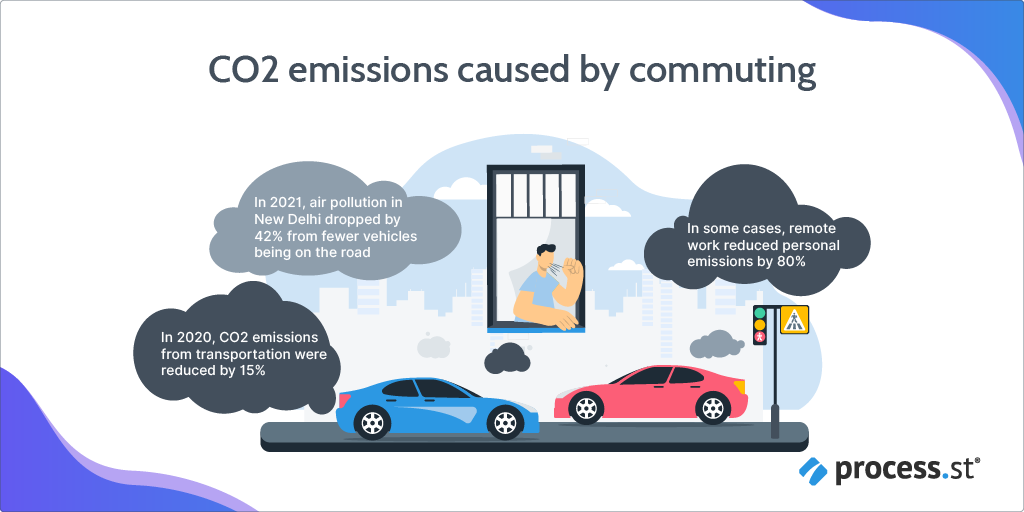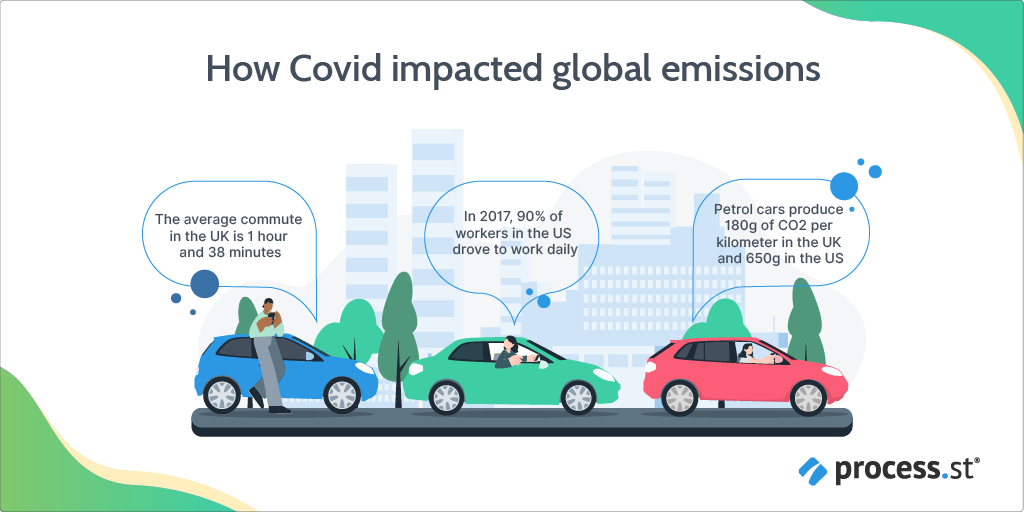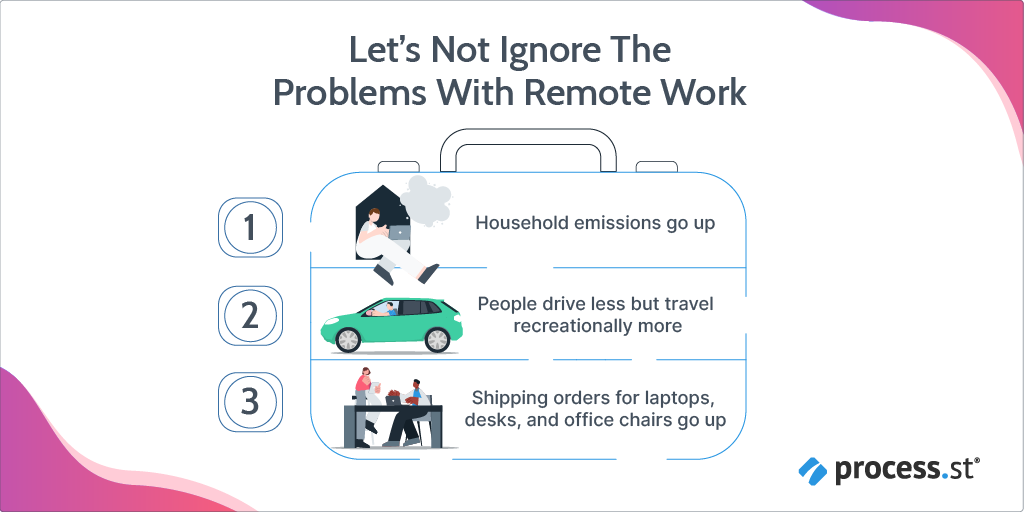
When the Covid-19 pandemic hit in 2020, the world completely changed for a period of time. While it’s a time most of us would happily forget, many of the shifts that came about are becoming permanent staples in our society moving forward, particularly with work.
When Covid shut everything down, suddenly those who work in offices found themselves having to adjust to working from home. Some hated it and couldn’t wait to get back to the office, and others loved it, wanting it to become their normal, even post-pandemic.
While remote work peaked in 2020, working from home and hybrid working are still at much higher rates than they were pre-pandemic, and there’s no sign that will change anytime soon.
This sudden increase in remote work has given us the opportunity to measure how remote work compares to onsite work in terms of environmental impact. In a time where the fate of the planet rests on this generation’s shoulders, we need to find as many ways as possible to reduce CO2 emissions.
However, despite popular belief, is working remotely actually better for the planet than working in an office?
In this article, I will attempt to answer that question. We will cover:
- Environmental impacts of the workplace
- How remote work changes things
- What about a hybrid model?
- So what is the solution?
Environmental impacts of the workplace
I remember the news stories during lockdown in 2020 well. The canals of Venice became clear; New Delhi had the longest period of clean air ever recorded. Nature seemed to heal itself very quickly with the sudden absence of cars, planes, motorcycles, and just people in general.
So if most of the pollution we create is associated with going to and being at work, then switching to remote work must be far better for the environment, no?
Well, it’s difficult to say because it’s not that simple. But let’s take a look at the environmental impact commuting and workplaces have.
Commuting
Commuting is not necessarily one-size-fits-all. Americans reading this might associate commuting with driving, the Japanese might associate it with taking the train, and the Dutch might associate it with riding a bike. For our purposes, we will focus on commuting by car as it has the highest environmental impact.
Let’s look at the facts:
- In the UK, workers spend an average of 1 hour and 38 minutes commuting each day.
- In 2017, a survey showed that 90% of workers in the US commuted by car.
- Petrol cars produce 180g of CO2 per kilometer in the UK.
- Petrol cars produce 650g of CO2 per kilometer in the US.
- Personal vehicles make up more than half of the greenhouse gas emissions from the transportation sector.
- In 2020, CO2 emissions from transportation were reduced by 15%.
- In 2021, air pollution in New Delhi dropped by 42% from fewer vehicles being on the road.
- Emissions shot back up to pre-pandemic levels when people went back to the office.
There’s no denying the massive environmental impact commuting has. Cars also emit a lot of nitrous oxide, more than they do CO2. This is a big problem because nitrous oxide is 300 times more potent than carbon dioxide.
It’s no wonder that when everyone started working from home, many of those who drive to work saw their personal emission drop by as much as 80%.
However, those who take public transportation or cycle to work did not see the same reduction in their emissions. In fact, some may have seen an increase in their total emissions, but we’ll get into the why of that later.
Energy used in the office
Was the reduction of cars on the road every day good for the environment? Yes, undoubtedly. Was the reduction of energy used in offices good for the environment? Not in every case.
Trigger warning: We’re about to do some math.
So, in California, an office space for a company with 90 employees generates roughly 234 tons of carbon dioxide per year. That works out to 2.6 tons per employee, not counting the additional emissions from commuting, which would, on average, add an additional 4.6 tons of CO2. This brings the total amount of emissions per employee to 7.2 tons per year.
That’s a staggering amount!
By comparison, the average three-resident household in California produces 4.17 tons of CO2 per year or 1.39 tons per resident. We can’t know exactly how much energy usage increases with people working from home, but it likely would not be as much as the 2.6 tons produced in an office setting. And with the reduction of emissions from commuting, in this example, working from home would be the more sustainable option.
However, as I said before, emissions are not always reduced when people transition into remote work.

How remote work changes things
Remote work certainly makes it easier for individuals to reduce their personal emissions. And companies as a whole can reduce their emissions by foregoing offices altogether. Of course, not every business can be fully remote, but most, if not all, of those who solely operate in the digital space, can.
Moving to a fully remote model can save companies tons of money. McKesson, a medical supply company, found that by getting rid of their offices, they would save between $60 and $80 million per year.
The undeniable benefits
We’ve already confirmed the biggest environmental benefit of remote work sustainability: cutting out commutes. But let’s put the amount of energy this would save into a larger context.
The International Energy Agency (IEA) analyzed commuter trends and labor market data and found that if all employees were allowed to work from home one day a week, it would save 24 million tons of carbon emissions, equivalent to the amount emitted by Greater London.
That’s just one day a week!
Now I know what you’re thinking: Not everyone can work from home. That’s true, and I hear you.
Research suggests that 20% of all workers could work from home full-time without ever needing to be onsite. If that 20% of employees are allowed to work remotely, we could see the same environmental benefits as the IEA’s analysis suggests.
With the reduction of greenhouse gas emissions, we would also see:
- Less plastic pollution
- Better air quality
- Less strain on infrastructure
How do we know this? Because we already saw it during the Covid lockdowns!
Why remote work isn’t always a positive for the environment
Things are rarely black and white. I wish this piece could just be onsite work bad, remote work good. But it’s not that simple.
“Remote working has not delivered the environmental benefits that some people expected.” –
Steve Sorrell, professor of energy policy at the University of Sussex
For our hypothetical Californian company, transitioning to remote work was ultimately better for the environment. But what about in places where people take public transportation or cycle to work? What about people who live in cold climates?
Emissions would increase for these individuals. Instead of heating one office building, every employee would heat their individual home. Salesforce’s head of emissions reduction, Amanda von Almen, said that during the pandemic the company’s emissions didn’t go down; they were just moved around as people began working from home.
And then there are the big tech companies like Meta and Google, who have invested billions into their sustainable campuses. It’s safe to say that most of their thousands of employees don’t have homes that only run on solar. For companies like that, the benefit of reduced commutes is all but negated by people working from home.
Not to mention the emissions that have been caused by people setting up home offices. Between April and June 2020 alone, orders for office chairs increased by 300%, and orders for desks went up by 438%. The production and shipping of home office furniture and supplies do little to reduce carbon emissions.
Remote work has also increased the demand for larger houses to accommodate the additional office space. There has been an increase in people moving away from cities to more rural areas, increasing the amount they have to drive if they ever do have to go into the office. As people spend more time at home, they desire more space to make that time more comfortable. While it’s understandable, it’s not exactly environmentally friendly.
With remote work, people tend to travel recreationally a lot more. Chasing that digital nomad lifestyle and whatnot. And no shade to the digital nomads of the world, but we can’t lie to ourselves and think that it’s a sustainable way to live and work.

What about a hybrid model?
A hybrid working model seems like a great compromise for people seeking a better work-life balance. But how does it compare with onsite and remote work?
The shift to hybrid
Many companies have been wary of adopting a fully remote model. It could be that they don’t want to give up their offices or their employees don’t enjoy being fully remote. Or both, really.
A hybrid working model is great for employees who crave the increased flexibility it brings. Employees enjoy the freedom of being able to more or less choose the days they go into the office and the days they stay home.
Hybrid work has been shown to improve employee retention and improve their mental health altogether. With benefits like that, it’s no wonder that more and more companies are shifting to a hybrid model instead of going fully remote.
But is it better or worse for the environment?
Benefits and bottlenecks
The environmental benefits of a hybrid working model are few, I’m afraid.
If people don’t move further away from where they work, then the one and only benefit we’ve seen so far is the reduction of commutes. However, with people moving further away from city centers and opting for larger houses, that benefit shrinks and shrinks.
Not to mention the extra energy it takes to power people’s homes when they’re there all day. With a hybrid model, people’s homes are consuming more energy and office buildings are consuming the same amount of energy as they were before.
In 2021, Carbon Trust, a consultancy based out of the UK, wrote a report on remote work in which they stated:
“In a worst-case scenario, a hybrid working future could…create a world where buildings and homes are used inefficiently with a transport system that is unable to respond to changing demand and potentially more cars on roads.”
Experts believe that an environmentally-friendly hybrid model could be possible, but that it’s still too early to know how to do it.

So what is the solution?
Often when it comes to environmental issues and challenges, we tend to oversimplify solutions. We might be tempted to say that remote work is the most environmentally-friendly way to work, but as we saw, that’s not the case for every company.
While it may be the best model for an all-remote, international company like Process Street, which has never had offices, the switch to remote isn’t the best option for others.
Hybrid working is really showing to be the worst for the environment overall, but again that’s a generalization. Some companies out there may be doing a great job of making hybrid work sustainable, and we just don’t know about it yet.
The point is, in order to decide what type of working model is the most sustainable for your company, there’s a calculator you can use to compare different working scenarios.
When the software company Buffer tested its own emissions and compared onsite vs. remote working for the company, they found that a remote model was the most sustainable option for them. You never know until you compare the numbers.
Ultimately, the climate crisis is by far the biggest thing affecting our future. Looking for more sustainable ways to live on the individual and small business levels is really great, but the reality is that it isn’t going to make a dent in the problem. We need sweeping and dramatic changes to combat the changing climate, as evidenced by the Intergovernmental Panel on Climate Change (IPCC) report in 2018.
Until homes and offices are all powered by renewable energy, the debate of which working model is best for the planet will keep going. For now, the best solution is to adopt the most sustainable option for your company. It may not be the perfect solution, but it’s the best we can do for now until the powers that be make the changes we really need.
We would love to hear from you: which model your company uses, if you have changed it since the pandemic, and whether you feel your emissions have gone up or down. Feel free to comment below.







Isabella Busby-Priest
Isabella Busby-Priest is a content writer with a keen interest in all things environment, nature, travel, and culture. When she's not creating new blog content, you'll often find her reading in odd places or planning a trip to a new country.